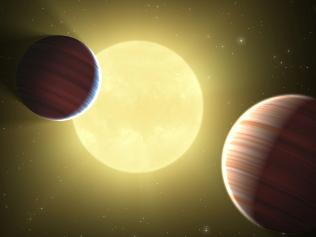International astronomers said on Thursday they have found the fourth potentially habitable planet outside our solar system with temperatures that could support water and life about 22 light-years from Earth.
 |
Planets orbit around GJ 667Cc. AFP |
The team analyzed data from the European Southern Observatory about a star known as GJ 667C, which is known as an M-class dwarf star and puts out much less heat than our Sun.
However, at least three planets are orbiting close to the star, and one of them appears to be close enough that it likely absorbs about as much incoming light and energy as Earth, has similar surface temperatures and perhaps water.
The new rocky planet, GJ 667Cc, orbits its star every 28.15 days -- meaning its year equals about one Earth month -- and has a mass at least 4.5 times that of Earth, according to the research published in Astrophysical Journal Letters.
“This planet is the new best candidate to support liquid water and, perhaps, life as we know it,” said Guillem Anglada-Escud, who was with the Carnegie Institution for Science when he conducted the research but has since moved on to the University of Gottingen in Germany.
The theory about water, however, cannot be confirmed until astronomers learn more about the planet’s atmosphere.
Other planets circling the same star -- which is part of a three-star system -- could include a gas-giant and an additional super-Earth with an orbital period of 75 days, but more observations are needed to confirm that.
Some experts have been skeptical that M-class dwarf stars could have planets that support life because they are too dim and tend to have lots of solar flare activity which could send off lethal radiation to nearby planets.
And even though this star, GJ 667C, has a much lower abundance of elements heavier than helium, such as iron, carbon, and silicon -- the building blocks of terrestrial planets -- than our Sun, astronomers are intrigued by the possibilities.
“This was expected to be a rather unlikely star to host planets. Yet there they are, around a very nearby, metal-poor example of the most common type of star in our galaxy,” said co-author Steven Vogt, a professor of astronomy and astrophysics at University of California Santa Cruz.
“The detection of this planet, this nearby and this soon, implies that our galaxy must be teeming with billions of potentially habitable rocky planets.”
French astronomers in May last year confirmed the first exoplanet, Gliese 581d, to meet key requirements for sustaining life. It is a rocky planet about 20 light-years away.
Swiss astronomers reported in August that another planet, HD 85512 b, about 36 light-years away seemed to be in the habitable zone of its star.
The US space agency NASA confirmed its first such planet late last year, Kepler 22b, about 600 light-years away. (AFP)
<관련 한글기사>
생명체 서식 가능성 가장 높은 슈퍼지구 발견
지구에서 불과 22광년 거리에 있는 저온의 별 주변에서 지금까지 발견된 것 가운데 생명체 서식 가능성이 가장 높은 행성이 발견됐다고 스페이스 닷컴과 사이언스 데일리가 2일 보도했다.
미국 카네기 과학연구소 등 국제 연구진은 이 외부행성이 우리 태양과는 성분이 다른 세 개의 별로 이루어진 항성계에서 발견돼 생명체가 생존할 수 있는 환경이 생각보다 훨씬 다양함을 보여주고 있다고 천체물리학 저널 최신호에 발표했다.
연구진은 유럽남부천문대(ESO)가 이미 발표한 자료를 새로운 기법으로 분석하고 하와이 케크 천문대의 에셸분광기와 칠레에 있는 카네기 행성추적 분광기 자료를 종 합해 이런 성과를 얻었다.
3중성계에 속하는 별 `GJ 667C’ 주위를 28.15일 주기로 도는 행성 ‘GJ 667Cc’는 질량이 지구의 4.5배이며 지구가 받는 광선량의 90%를 받는 것으로 나타났다.
이 행성이 받는 광선의 대부분은 적외선이어서 행성에 흡수되는 에너지의 비율이 지구보다 높지만 이런 점을 계산에 넣더라도 지구가 태양으로부터 받는 것과 비슷한 양의 에너지를 중심별로부터 받는 것으로 보인다.
따라서 이 행성의 표면 온도는 지구와 비슷해 “지금까지 발견된 행성 중 물, 더 나아가 어쩌면 생명체가 있을 가능성이 가장 큰 슈퍼지구 후보”라고 연구진은 밝혔다.
연구진은 중심별 GJ 667C 주위를 7.2일 주기로 도는 행성 ‘GJ 667Cb’가 존재한 다는 것을 이미 알고 있었으나 중심별과의 거리가 너무 가까워 액체 상태의 물이 있지는 않을 것으로 추정했었다.
학자들은 이 항성계에 공전주기 75일의 또 다른 슈퍼지구와 거대 가스행성이 있을 것으로 보고 있지만 이를 확인하기 위해서는 추가 관찰이 필요하다고 지적했다.
연구진은 “이 항성계는 우리 이웃이다. 이보다 가까운 별은 100개 밖에 안 된다” 고 강조했다.
또 한가지 흥미있는 사실은 GJ 667C가 우리 태양 질량의 3분의1 밖에 안되는 M급 왜성으로 그리 밝지는 않지만 지상 망원경으로도 볼 수 있으며 다른 두 별 GJ 66 7A와 B도 훨씬 멀긴 해도 뚜렷하게 보인다는 것이다.
연구진은 이 3중성계는 철이나 탄소, 규소 같은 중원소 성분이 매우 적어 처음엔 행성을 거느릴 것으로 기대조차 하지 않았다면서 새 행성의 발견은 생명체 서식 가능 영역이 생각보다 훨씬 다양할 가능성을 말해주는 것이라고 강조했다.
이들은 이처럼 가까운 곳에서 슈퍼지구가 새로 발견됐다는 것은 미항공우주국 (N ASA)의 케플러 망원경이 놓치기 쉬운 영역의 탐사 가능성을 의미하는 것이라고 지적 했다.
케플러 망원경의 추적 대상은 수천 광년 거리에 있는 천체들로 탐사선을 보낼 가능성이 없지만 “가까운 천체라면 언젠가는 로봇 탐사선을 보낼 수도 있고 몇백년 안에 엽서도 받아볼 수 있을 것”이라고 연구진은 말했다.








